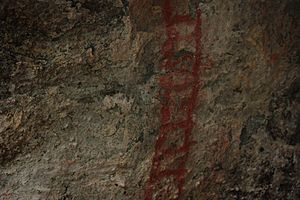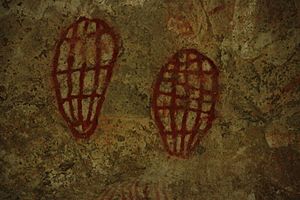Ngaro people facts for kids
The Ngaro are an Aboriginal Australian people. They traditionally lived on the Whitsunday Islands and the nearby coast of Queensland, Australia. They were known for their strong connection to the sea. Evidence shows people have lived in this area for about 9,000 years.
Sadly, the Ngaro society faced many challenges. Warfare with traders, colonists, and the Native Police greatly harmed their communities. In 1870, the remaining Ngaro people were forced to move. Some went to a penal colony on Palm Island. Others were sent to work in lumber mills on Brampton Island.
Contents
Ngaro Language
The Ngaro people had their own language. Today, this language is no longer spoken. Experts are not entirely sure if it was a unique language or a dialect. It might have been part of the Wiri or Giya languages. Both Wiri and Giya are dialects of the larger Biri language family.
Where the Ngaro Lived
The Ngaro people lived across about 520 square kilometres (200 square miles). Their territory included the Whitsunday and Cumberland islands. It also covered coastal areas around Cape Conway. Their land reached inland to the mountains east of Proserpine.
South Molle Island was very important to the Ngaro. It was a quarry where they found stone for making tools. Hook Island's Nara Inlet shows the earliest signs of Ngaro life in the area. This helps archaeologists learn about their ancient history.
Today, a group of Traditional Owners helps manage the land. This group includes representatives from the Ngaro and other local Aboriginal peoples. They work to protect natural resources and cultural heritage sites.
Ngaro Community Life
The Ngaro people lived in different family groups. One of these groups was called the Googaburra. These groups helped organize their society and daily life.
Ngaro Lifestyle and Culture
Whitsunday Island was a central place for the Ngaro. It was their only permanent home. The Ngaro were famous for their special canoes called winta. These canoes were made from ironbark and had three pieces sewn together.
Even though some thought outrigger canoes didn't reach this far south, Captain James Cook's journals show otherwise. When he arrived in 1770, the Ngaro were already using outriggers.
Travel and Food
The Ngaro used their winta canoes for travel and fishing. They sailed among the islands and along the reefs. They knew the reefs between St.Bees and Hayman Island very well. They even traveled about 100 kilometres (60 miles) on the water.
Ngaro stories tell of their regular trips to the Great Barrier Reef. This reef is far from the mainland, about 70 kilometres (43 miles) away. They reached it in their canoes, showing their incredible seafaring skills.
Their diet included many things from the sea and land. They ate sea turtles, flying foxes, and fowls. They also gathered wild cherries, Burdekin plum, and damson berries. Shellfish like trochus and baler shells were also important. They even ate green ants and cockatoo apples.
The Ngaro were skilled hunters of large sea animals. They hunted small whales from their canoes. They used special barbed harpoons. These harpoons helped them tire out their prey instead of letting it bleed. This was safer, as it kept sharks away from their catch.
Trade and Art
The Ngaro traded with people on the mainland. They exchanged items like baler shells, which they used to carry water. They also traded juan knives. These knives were made from stone found at South Molle Island. This island had one of Australia's largest stone quarries before Europeans arrived. Ngaro artifacts have been found far inland and along the coast.
Rock Art at Nara Inlet
The oldest signs of human life in the area are at Nara Inlet on Hook Island. You can still see cave openings and shell mounds, called middens, on the steep slopes.
One famous painting shows a hashed oval shape. Many believe it represents a sea turtle shell, a key food source. However, it might also show the fruit or seed of the pandanus plant.
Ngaro History with Europeans
Early European settlers estimated the Ngaro population was about 100 people. This was a high number for an island population. Diseases brought by Europeans might have already reduced their numbers.
The Ngaro faced many challenges as white settlers moved into their area. There was warfare, and their land was taken. Diseases also spread. The Native Police Corps caused great harm.
The final blow came in 1870. The Ngaro were forcibly moved. Some were sent to a mission settlement on Palm Island. Others were forced to work in timber mills on Brampton Island.
Even today, some descendants remember old songs. These songs are a mix of Ngaro and Biri words, keeping their heritage alive.
Other Names for Ngaro
- Ngalangi
- Googaburra
Some Ngaro Words
- winta (canoe)
Images for kids





